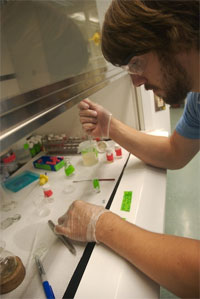Computer Docking of Substrates and Inhibitors with Xylanase and Laccase
Who’s Involved?
- Barbara Cole
- Ray Fort

Research Introduction
We are building computer models of the enzymes that hydrolyze the bonds between sugars in hemicelluloses (xylanases), and those that oxidize lignin (laccases). The models allow us to study how the enzymes interact with their normal substrates and with other compounds that may reduce the effectiveness of the enzymes. We can then predict the systems in which the enzymes may best be used.
Research Details
We are using AutoDock, v. 3.0, with the Lamarckian genetic algorithm to examine the interaction of various molecules, such as aryl glycosides, small lignin fragments, and small sugars with xylanases and laccases. The program tests the interaction between the enzyme and ligand at randomly chosen sites in the vicinity of the enzyme, and calculates a “binding energy”, which is the sum of the van der Waals and electrostatic interaction between the enzyme and the ligand. In principle the best binding energy should be observed when the ligand is properly oriented in the enzyme catalytic site. In this way, we have shown that lignin fragments bind competitively to xylanases and sugars bind competitively to laccase, and each substrate thus should act as in inhibitor of the opposite enzyme. This prediction is being tested in the laboratory.
Other Partners On This Project
This work is being performed by Mai Nguyen (PhD candidate), Dylan Montgomery (MS candidate), and Andru O’Farrill (NSF-REU student), with support from both the FBRI and the USDA.
What’s New on this Project?
Stimulated by a presentation at the ICBPPI, we have shown that the commercial laccase mediator, hydroxybenzotriazole, does bind to xylanase from T. viride in a position to prevent the xylanase from hydrolyzing the glycosidic bond. We also predict, based on docking, that simple sugars will inhibit laccase by competitive binding to the catalytic site.
